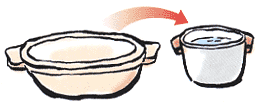Hot pot meals are healthy and easy to prepare and are often a feature of family get-togethers. An essential item for hot pot cooking is a donabe, a Japanese earthenware or clay pot. Like other earthenware pots, donabe emit far-infrared radiation that makes ingredients taste more delicious. Donabe also play a role in environmentally conscious living, as they retain heat better than metal hot pots, which means less gas and electricity consumption. As you use a donabe more and more, you will also come to enjoy its changing patina.
How to use your donabe safely
Donabe can be a fire hazard if used for deep-frying, so it is not advisable to use one for preparing dishes such as tempura or other deep-fried foods. Donabe should only be heated up when containing liquids. Donabe are not recommended for use on electric stoves because the heat is too intense. Finally, a donabe that is still warm should never be suddenly placed somewhere cold.
First wipe your donabe dry
Before using your donabe, wipe any water off the outer surface of the pot. Start cooking with the pot on a low heat.
Is there any leftover broth still in your donabe?
 Any leftover broth should be quickly transferred from the donabe to another container, and the pot should be rinsed in lukewarm water before washing it thoroughly using a sponge and neutral detergent.
Any leftover broth should be quickly transferred from the donabe to another container, and the pot should be rinsed in lukewarm water before washing it thoroughly using a sponge and neutral detergent.
Also make sure to remove food remnants
Soak your donabe in hot water and a neutral detergent and scrape off any food remnants using disposable chopsticks or a similar implement. A donabe should be washed promptly and kept nice and clean.
Be sure to wash the base of your donabe thoroughly too.
Wash the unglazed base of your donabe in the same manner as the inside of the pot, using a neutral detergent. Dry the pot thoroughly after washing by placing it upside down so that all remaining water drips out properly.
Use the original cardboard box for storing your donabe
Cardboard is highly absorbent and will protect your donabe from atmospheric humidity.

Tips for using your donabe
Vinegar is effective in removing musty odors
Remove odors by making use of vinegar’s anti-bacterial and deodorizing properties. Fill your donabe with plenty of water and add approximately 2–3 tablespoons of vinegar. Simply boil this mixture for about 10 minutes to remove musty odors.
Food odors can be removed with used tea leaves
Fill your donabe with plenty of water and a handful of used tea leaves (green tea, hojicha tea, etc.), place on the stove and boil for about 10 minutes. Tea contains components that will absorb unpleasant smells.
Cracks can be filled with rice-porridge starch
If cracks are left unattended, they will encourage bad odors and mold. Should you notice any cracks in your donabe, respond quickly by heating up some rice porridge (congee) in the pot to fill the cracks with its starch. Boiling up some left-over rice will also do the trick.
Induction cooktop-compatible donabe
Induction is a cooking technology that does not use heat. While it is a convenient cooking technology, it should be utilized effectively by cooking in magnetic cookware especially developed for induction cooktops and using the cookware properly based on a clear understanding of its characteristics.
Take care to avoid burning the bottom of your donabe
When food burns to the bottom of a donabe, it acts abnormally and generates ultra-high temperatures. This destroys the special coating inside the donabe, so take due care when cooking.
Are you using your donabe as a storage container?
Induction cooktop-compatible donabe are highly water absorbent, so please do not use them as storage containers. After finishing cooking, quickly transfer any leftovers to a separate container, so that you can use your donabe again.
Look after the coating with a sponge
Please avoid using domestic cleansers or metallic kitchen scrapers on the special coating inside your donabe. Use a sponge and neutral detergent instead.
Be aware and take heed of a donabe’s special characteristics
Please do not use your donabe for preparing dishes such as tempura or other deep fried foods. Also, donabe should only be heated up when containing liquids and should not be soaked for a long period of time when being washed, as this will cause damage and malfunction. While cooking, you may occasionally notice a humming or buzzing sound. This does not indicate any abnormality. Repositioning the pot or removing it and placing it on the cooker once again should put an end to the sound.
Tips for using your donabe
Reducing the cooking time
Bring broth to boil ahead of time to heat up the sides of the donabe. This will reduce the time required to re-boil the broth after adding the main ingredients. You will also be able to reduce the heat somewhat to lessen the risk of food burning.
Highly viscous ingredients
When cooking highly viscous ingredients in your donabe, especially rice-cakes, rice-porridge, zosui, kombu, udon noodles, beaten eggs, and the like, please take care to observe the following:
- Where possible, try to avoid placing highly viscous ingredients on the bottom of the pot. Place them on top of other ingredients instead
- Ensure that adequate liquid remains in the pot. Take care to avoid boiling down or accidentally burning food
- Filling the pot about 80 percent full of ingredients is ideal. Over-filling the pot can cause food to burn
- Stir ingredients a little sooner and a little more often than usual to avoid burning food to the bottom of the pot
- To keep food warm, adjust the heat by lowering the temperature
